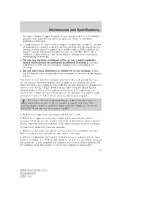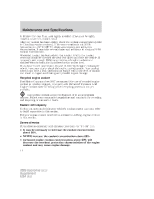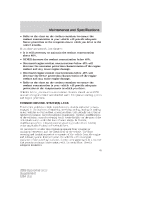2005 Ford F350 Diesel Supplement 3rd Printing - Page 48
2005 Ford F350 Manual
Page 48 highlights
Maintenance and Specifications • Try operating the starter switch several times. Should the switch be corroded, this operation may clean the contacts or make the switch temporarily operable until you can reach the dealer. • If all electrical connections are tight and you need assistance to start, refer to Jump starting in the Roadside Emergencies chapter of your Owner's Guide (F-Super Duty and Excursion) or refer to the Jump starting section in the Roadside Emergencies chapter of this supplement (E-Series). If engine cranks but won't start Prolonged starter cranking (in excess of 30 seconds) could cause damage to the starter motor. • Check the fuel gauge. You may be out of fuel. If the gauge shows that there is fuel in the tank, the trouble may be in the electrical system or the fuel system. If equipped with an auxiliary tank, be sure that the tank control switch is set for the tank with fuel and not on an empty tank. • Leaving the ignition key turned to 4 (ON) for over two minutes without starting may make starting difficult because the glow plugs will cease activation. Reset the system by turning the ignition key to 3 (OFF) and then back to 4 (ON) again. If the engine runs hot The following could cause the engine to overheat: • Lack of coolant. • Dirty cooling system. • Plugged radiator fins, charge air cooler, A/C condenser and/or oil cooler. • Driving with frozen coolant. • Sticking thermostat. • Overloading or pulling heavy trailers during hot weather. • Grill or radiator air blockage. • Slipping or missing drive belt. • Plugged or very dirty air cleaner element. If fuses burn out Burned-out or blown fuses usually indicate an electrical short-circuit, although a fuse may occasionally burn out from vibration. Insert a second 48 2005 Econoline (eco) Supplement USA (fus)
















